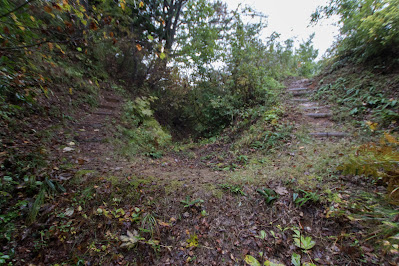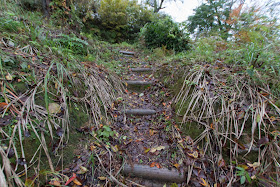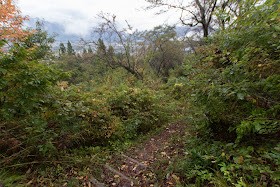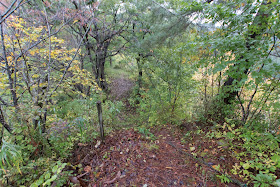Kabanosawa Castle
-Irreconciable conflict after god of war (9) defense of hometown-
Overview
Name: Kabanosawa castle (Kabanosawa-jo)
Alias:
Place: Kabanosawa Minami-Uonuma city, Niigata
Type: Mountain Castle
Built: 16th century
Remaining remnants: Clay walls and moats
Title:
Brief History
Continued from Part 8
Kabanosawa castle (樺沢城) is located over Shiroyama mountain, one of about 100 meter height from hillside near from Joetsu Kokusai Ski Field station at 5 kilometer southwest from Minami Uonuma city central. Uonuma Kyuryo hills run between Uono-gawa river and Shinano-gawa river north and southward for 30 kilometer long, and castle site is at the east edge of the hill.
There are three mountain roads across Uonuma Kyuryo hill from Tokamachi area to Muikamachi area, that are the north road crosses Hakka-Toge pass, middle road over Tochikubo-Toge pass, and south road runs Osawa-Toge pass. Today north road is modernized by tunnel and became the major one as Route 253, but formerly Hakka-Toge route was the main route among three passes.
This route was not only connected both side of the hill, but at the east end of Matsunoyama Kaido road which connected current Joetsu area and Uonuma area, across Higashi Kubiki Kyuryo hills and Uonuma Kyuryo hills over 60 kilometer long. Castle site is at the middle of the east end of middle road and south road, and meeting point of these roads and Mikuni Kaido road toward Kanto region across Mikuni Toge pass.
Origin of Kabanosawa castle
The origin of Kabanosawa castle is not clear but it might be built by local lord Tanaka clan in the early period of Muromachi era. Ueda Nagao clan, which was the lord of Uonuma area, was a branch family of Nagao clan that entered into Echigo province (Niigata prefecture) as a deputy governor of province under Uesugi clan, that was an important retainer of Muromachi Shogunate and served as Kanto Kanrei, general minister of Kanto region.
After entrance in the middle of 14th century, Ueda Nagao clan gradually grew their territory to whole part of Uonuma basin letting local lords which were descendants of Nitta clan subordinate. By the middle of 15th century Ueda Nagao clan established the dominance of Uonuma basin, then prepared branch castles around the territory.
At this time Kabanosawa castle might be built as a genuine castle, as an important branch castle worked as a last defense line of Sakado castle (Niigata prefecture), the main base of Ueda Nagao clan. toward Joetsu area and Kanto region. Ueda Nagao clan placed Kuribayashi clan, the highest class retainer of the clan, then this shows the importance of Kabanosawa castle.
Branch castle of Ueda Nagao clan
In the former half of 16th century, among the conflict between Uesugi clan and deputy governor Tamekage Nagao (1486-1543), or another conflict between two sons of Tamekage it mean Harukage Nagao (1509-1553) and Kagetora Nagao (1530-1578, later Kenshin Uesugi), Ueda Nagao clan was involved into the conflict but there was no record of combat at Kabanosawa castle.
As a result of conflict with Kenshin Uesugi, Masakage Nagao (1526-1564), the leader of Ueda Nagao clan, married with Lady Sentoin (1528-1609) who was the elder sister of Kenshin Uesugi, and became the retainer of Kenshin. Lady Sentoin deeply believed Ryutakuji temple at the front of the castle and donated statue of Bodhisattva to the temple.
Beside, her husband Masakage Nagao also stayed at Kabanosawa castle where was convenient to communicate with Kenshin Uesugi at Kasugayama castle (Niigata prefecture). Therefore, their son Kagekatsu Uesugi (1556-1623) is said to be born at Kabanosawa castle.
Castle at military road of Uesugi clan
In 1564, Masakage Nagao died in accident then Kagekatsu Uesugi succeeded Ueda Nagao clan. But Kagekatsu was still too young then his uncle Kenshin Uesugi who did not marry and have son adopted Kagekatsu Uesugi. Under the absence of its leader, Ueda Nagao clan was managed by ally of important retainers such as Kuribayashi clan or Higuchi clan.
In 1560’s, Kenshin Uesugi repeatedly made expeditions to Kanto region, to confront with Hojo clan which was the warlord of Sagami province (Kanagawa prefecture) and seized major part of Kanto region. Uesugi army marched from Kasugayama castle crossed Shinano-gawa river at Biwagake castle (Niigata prefecture), then passed Akibayama castle (Niigata castle) the crossed Tochikubo Toge pass.
Uesugi army crossed Shinano-gawa river and Uonuma Kyuryo hills might stay at Kabanosawa castle, then meet the troop from middle part and north part of the province then turned southward to Yuzawa area toward Asagai Yorii castle (Niigata prefecture). Ueda Nagao clan prepared military road of Uesugi clan toward Kanto region and also Kabanosawa castle which protected the road.
Structure of Kabanosawa castle
Kabanosawa castle spreads the ridge spreads eastward. Central area of the castle is a crescent shaped one of about 70 meter long, which has corridor areas at front side and back side. Corridor area of front side is divided into separate compartment and worked as Umadashi style gate area. West ward of central area is connected to backside mountain thus divided by layers of large dry moats.
In front of central area, secondary area which is about 30 meter square exists before large dry moat separates the castle into upper half and lower half. Secondary area itself is a small area but connected to terraces at same level such as Enaduka area at east and Nishinomaru area at west, then might be used as a commanding space in case of combat.
Below of secondary area, again before large dry moat, third area exists which is an entrance area of the castle. Two roads from hillside merge at this area, and line of horizontal clay wall and dry moat spreads like a trench toward outside of the castle. Total size of the castle is about 400 meter long and 300 meter wide, and rough shape of the castle is a typical hill castle of Echigo province but covered by numerous small compartments and dry moats not seen in other castle.
Outbreak of internal conflict
Other than Kagekatsu Uesugi, Kenshin Uesugi had another adopted son Kagetora Uesugi (1554-1579), who was originally the person of Hojo clan but came to Echigo province at the time of temporal ally between Uesugi clan and Hojo clan. Soon both clans broke but Kenshin did not kill or return Kagetora and kept as an adopted son.
As Kenshin suddenly died in ill in 1578 not stating which of Kagekatsu Uesugi or Kagetora Uesugi became next leader of Uesugi clan, the internal conflict named as “Otate-no-Ran” started in May 1578 between Kagekatsu Uesugi at Kasugayama castle, and Kagetora Uesugi at Otate castle. Ueda Nagao clan was the home of Kagekatsu Uesugi, Uonuma area and Ueda Nagao clan strongly supported Kagekatsu Uesugi.
On the other hand, Kagetora Uesugi asked assistance to his home Hojo clan. Expecting the assault of Hojo army from Mikuni Toge pass, Ueda Nagao clan built Arato castle (Niigata prefecture) at the entrance of Uonuma basin. As Ueda Nagao clan did not have sufficient army, they concentrated at its main base Sakado castle, Kabanosawa castle, Arato castle or Jikiro castle.
Assault of Hojo army
The main force of Hojo army could not move due to confrontation to Satake army at Shimotsuke province (Tochigi prefecture), but Hojo clan ordered former retainers of Uesugi clan at Kozuke province (Gunma prefecture) turned to Hojo clan such as Kitajo clan or Kawada clan to intrude Uonuma area across Mikuni Toge pass.
In July, Hojo army intruded into Echigo province breaking the defense line of Ueda Nagao clan such as Arato castle. Next Hojo army attacked Kabanosawa castle, then captured it in August as a front line base faces Sakado castle, the main base of Ueda Nagao clan. Masayori Kuribayashi (?-1599), the commander of castle, barely escaped to Sakado castle.
Because of its geographic condition at the merging point of Mikuni Kaido road and Matsunoyama Kaido road, Kabanosawa castle was a good place to accept supplies from Kanto region, and also to shut the movement between Kasugayama castle and Uonuma area to prevent mutual assist. Being isolated, the fall of Sakado castle seemed not far.
Reverse of situation
But Sakado castle at high mountain well stood against the siege of Hojo clan with desperate fight of guarding soldiers. Even though lacked main troop, if Hojo army divide itself into two troops, then place one as restraint of Sakado castle and send another to support to Kagetora Uesugi with supplies, the tide of the battle could be changed. But without the leader of Hojo clan they could not decide to do so.
As a result, Hojo army could not fall Sakado castle until October 1578, the arrival of heavy snow season. For the fear of shut down of Mikuni Toge pass by snow, Hojo clan left two commanders Takahiro Kitajo (1517?-1587?) and Shigechika Kawada (?-?) at Kabanosawa castle and retreated. But without support and supply from Kozuke province, the moral of Hojo army at Kabanosawa castle significantly declined in heavy snow.
Looking at this opportunity, Kagekatsu Uesugi started counter attack both at Joetsu area and Uonuma area. Utilizing both of starvation tactics and forcible attack, Kagekatsu gradually suppressed Kagetora Uesugi besieged at Otate castle and fell it in February 1579. Kagetora Uesugi ran to Samegao castle (Niigata prefecture) but was rebelled by the commander then died in the castle.
Recovery of Kabanosawa castle and afterward
At the same time, Nagao Ueda army attacked Kabanosawa castle. Two commanders tried to protect the castle building dry moats, but finally opened the castle and returned to Kozuke province by February. In March Hojo army again intruded into Uonuma area, but Kagetora Uesugi already died then Hojo clan soon retreated from Echigo province.
Being left at snowy Kanabosawa castle without support and supply, Kitajo clan and Kawada clan strongly dissatisfied with the treatment of Hojo clan, then left Hojo clan and turned to Takeda clan. But this became the cause of conflict between Takeda clan and Hojo clan, then lead to the break of the ally of two clans.
After the cease of internal conflict, Kagekatsu who won the conflict appointed Masayori Kuribayashi as the lord of Kabanosawa castle. The castle might be kept as a major branch castle of Sakado castle, but might be abolished in 1598 when Kagekatsu Uesugi was transferred to Aizu basin by Toyotomi government.
Today no building remains but structure of the castle well remain over the hill. Next hill of the castle becomes huge skiing course, and this shows the difficulty of besiege at the castle in winter season. Kagekatsu Uesugi might be gland and sad by turns hearing the situation of Kabanosawa castle at distant Kasugayama castle, both from the tactical view of protecting roads and emotional standpoint of safety of hometown.
Continue to Part 10
Access
20 minutes walk from JR East Joetsu-sen line Osawa station. 30 minutes drive from Kanetsu Jidoshado Expressway Shiozawa-Ishiuchi interchange.
Related Castles
Sakado Castle - Irreconciable conflict after god of war (8) suspension bridge in the sky-
Kitajo Castle - Irreconciable conflict after god of war (10) shaken by destiny-









































































































































































































































































No comments:
Post a Comment